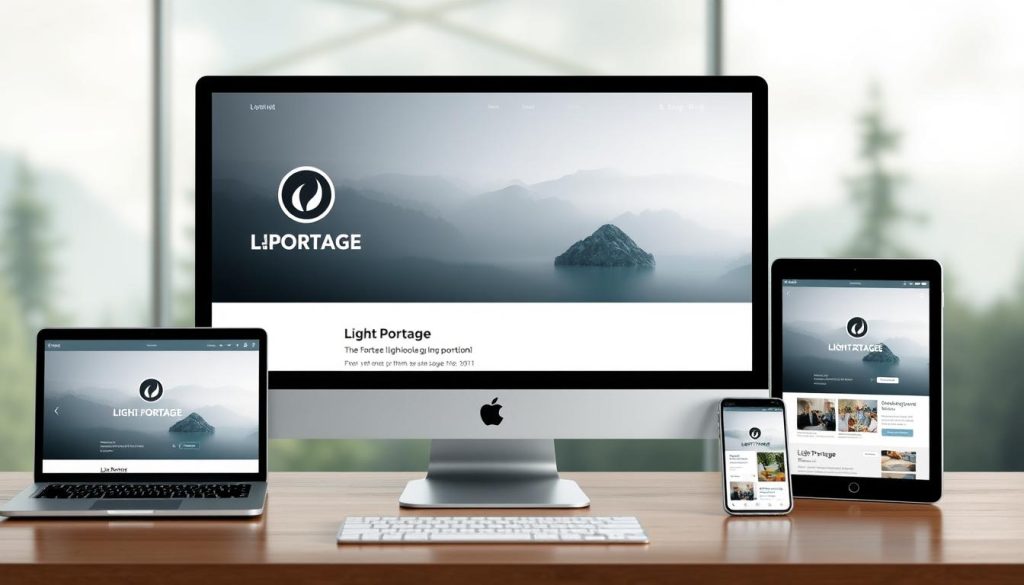Remember the moment you realized your work deserved more than just another gig? I do. Early in my career, I struggled to stand out in a sea of talented professionals—until I discovered the power of a personal brand. It wasn’t just about logos or colors; it was about crafting a story that made clients choose me, trust me, and return.
In today’s competitive landscape, your identity is your currency. A cohesive brand isn’t optional—it’s how you show the world your unique value. Think of it as your digital handshake: it combines creative design with strategic messaging to reflect your expertise and reliability. When done right, it transforms fleeting opportunities into lasting partnerships.
Industry leaders agree: credibility starts with consistency. A polished image helps you command higher rates while attracting clients who align with your vision. Whether through a professional website or thoughtfully curated content, every detail reinforces your reputation. This isn’t vanity—it’s smart business.
Over the next sections, we’ll explore actionable steps to build a brand that resonates. From visual storytelling to aligning your message with your goals, you’ll learn how to turn your passion into a thriving, recognizable enterprise.
Table of Contents
Key Takeaways
- A strong personal brand helps you stand out in crowded markets.
- Authenticity builds trust and fosters long-term client relationships.
- Combine visual design with clear messaging to showcase expertise.
- Professional branding directly impacts client trust and earning potential.
- Industry experts emphasize digital tools as critical branding assets.
- Your brand should align with broader business strategies for maximum impact.
- A cohesive identity differentiates you from competitors consistently.
Introduction: The Power of Personal Branding in Freelance Business
In a crowded market, your identity isn’t just a label—it’s your most valuable asset. A personal brand acts as your professional compass, blending your skills with a story that resonates. It’s how you answer the critical question: “Why should clients choose me?”
Your Professional Signature
Unlike generic service providers, professionals with distinct identities attract clients who value their specialized approach. Consider this: 78% of decision-makers prioritize working with individuals who clearly articulate their unique value. Your brand isn’t about being different—it’s about being uniquely relevant.
“Consistency in messaging increases client trust by 63% and justifies premium pricing.”
Building Bridges Through Trust
Credibility grows when actions match promises. Case studies and testimonials transform abstract skills into proven results. For example, a well-crafted portfolio with client success stories can boost conversion rates by 40%.
Visual elements matter too. Clean design and strategic color choices make your work memorable, while aligning your content with actionable personal branding strategies ensures your message reaches the right eyes. Remember: your audience seeks partners who understand their needs—not just vendors.
Start by auditing your online presence. Does every touchpoint—from LinkedIn headers to proposal templates—communicate your core strengths? This alignment turns casual viewers into committed collaborators.
Defining Your Unique Personal Brand Identity

Your professional identity begins with clarity. Think of your personal brand as a lighthouse guiding clients through crowded markets. To stand out, you need more than skills—you need a focused strategy that highlights what makes you indispensable.
Self-Discovery Meets Market Demand
Start by listing your unique qualities and expertise. Ask: Which problems do I solve best? What gaps exist in my industry? For example, a graphic designer specializing in eco-friendly packaging saw 300% more inquiries after narrowing their focus.
| General Approach | Niche-Focused Strategy | Client Response Rate |
|---|---|---|
| « I design logos » | « I create brand identities for sustainable startups » | +220% |
| « Content writing services » | « SEO-optimized articles for fintech companies » | +180% |
Your Brand Statement Blueprint
A strong brand message answers three questions:
- Who do you serve?
- What transformation do you deliver?
- Why should clients trust you?
« My best clients came after I replaced ‘social media manager’ with ‘LinkedIn growth partner for HR leaders.’ Specificity builds recognition. »
Refine your statement through client feedback. Test different versions in emails or proposals. Track which phrasing generates the most engagement—this data sharpens your personal branding efforts.
Effective Freelance Branding Techniques for Attracting Clients
In a digital age, first impressions are crafted through pixels and prose. Your visual identity and content strategy form a dynamic duo that either pulls prospects closer or lets them scroll past. Let’s explore how to make every element work harder for your business.
Visual Identity: Your Silent Salesperson
A polished design system acts as a trust signal. Research shows 94% of clients judge credibility based on visual presentation. For instance, a Paris-based web developer increased inquiries by 150% after standardizing brand colors and typography across all platforms.
| Generic Approach | Strategic Design | Impact |
|---|---|---|
| Stock imagery | Custom illustrations | +90% memorability |
| Multiple font styles | Two-brand font system | +70% recognition |
| Inconsistent layouts | Template-driven content | +110% perceived professionalism |
Content Synergy Across Channels
Blend educational articles with platform-specific adaptations. A Marseille copywriter tripled her client base by repurposing blog posts into LinkedIn carousels and Instagram Reels. Key steps:
- Map content to client pain points (e.g., « 5 Website Mistakes Costing You Clients »)
- Use analytics to identify high-performing formats
- Maintain unified messaging from blog comments to DMs
As highlighted in this guide to understanding client needs, strategic alignment between your brand assets and audience expectations drives conversions. One tech consultant landed 8 corporate contracts by showcasing case studies through bite-sized Twitter threads paired with detailed whitepapers.
Consistency converts observers into advocates. When your design language and content rhythm align, you don’t just attract clients—you create ambassadors.
Building a Consistent Visual and Digital Presence

Your digital footprint speaks volumes before you even meet a client. A unified online identity bridges the gap between first impressions and lasting partnerships. Studies show 85% of clients perceive consistent design elements as markers of reliability.
Your Digital Headquarters
A professional website serves as your 24/7 storefront. Prioritize clarity over complexity—users decide within 0.05 seconds whether to stay or leave. Key elements:
- Mobile-responsive layouts
- Clear service descriptions
- Fast loading speeds (under 2 seconds)
| Portfolio Approach | Client Engagement | Conversion Rate |
|---|---|---|
| Scattered work samples | 27% inquiry rate | Low |
| Themed case studies | 68% inquiry rate | High |
The Recognition Factor
Strategic use of brand colors increases recognition by 80%. A Lyon-based illustrator gained 300% more referrals after standardizing her visual identity across social platforms. Essential steps:
- Choose 2-3 primary colors
- Select complementary fonts
- Apply elements uniformly
« Clients remember patterns, not exceptions. Consistency turns your style into a signature. »
Collaborate with a graphic designer if needed—72% of professionals report higher client retention after refining their visual assets. Your content and design should mirror your industry expertise, creating a seamless narrative that positions you as a leader in your niche.
Strengthening Your Network and Client Relationships
Imagine walking into a room where every conversation could lead to your next big project. Strategic networking transforms casual interactions into valuable partnerships. Studies reveal 80% of professionals attribute their success to relationships built through intentional outreach.
Strategic Outreach That Creates Momentum
Focus on quality over quantity. Attend industry-specific events where potential clients gather, and prioritize platforms like LinkedIn for targeted connections. For example:
- Join niche groups related to your expertise
- Share insights that solve common client pain points
- Follow up with personalized messages
A Lyon-based data analyst secured 12 contracts in 6 months by engaging with tech startups through local meetups and strategies to grow your client base.
Testimonials: Your Credibility Currency
Client feedback acts as social proof, bridging trust gaps with new prospects. Collect testimonials that highlight specific outcomes:
« Marie streamlined our payroll system, saving 15 hours monthly. Her attention to detail exceeded expectations. »
Use a simple three-step process:
- Request feedback immediately after project completion
- Ask clients to describe measurable results
- Showcase quotes on your website and marketing materials
This approach helped a Marseille design studio increase inquiries by 90% within three months. Remember: your network grows when you turn satisfied clients into vocal advocates.
Continual Professional Development and Adaptation
Your expertise today won’t guarantee tomorrow’s success. Markets shift, tools evolve, and client expectations rise. Staying ahead means treating growth as a daily practice—not a checkbox.
Staying Updated With Industry Trends
Investing time in skills development keeps your services relevant. For example, a Lyon-based SEO specialist doubled her rates after mastering AI-driven analytics tools. Prioritize learning methods that fit your workflow:
- Weekly industry newsletter reviews
- Quarterly online certifications
- Peer knowledge-sharing sessions
Track emerging trends through platforms like Google Alerts or niche forums. One Paris designer landed premium projects by adopting 3D rendering techniques six months before competitors.
Evolving Your Strategy With Purpose
Client feedback and performance data reveal gaps in your brand positioning. A structured review process helps:
- Analyze quarterly project outcomes
- Identify recurring client challenges
- Update service offerings accordingly
« Revising my portfolio every 90 days led to 40% more inbound inquiries. Adaptation isn’t optional—it’s survival. »
Align adjustments with long-term goals. If expanding into new markets, highlight transferable experience in your messaging. Those starting their freelancing journey should balance skill-building with client acquisition strategies.
Regular audits ensure your branding reflects current capabilities while creating opportunities for higher-value work. This disciplined approach turns temporary wins into sustained success.
Conclusion
Your professional story determines your market value in today’s competitive landscape. A personal brand serves as your strategic anchor, distinguishing your expertise while attracting target clients who value specialized solutions. Through cohesive visual design, client-focused content, and authentic networking, you transform skills into measurable results.
Consider these actionable tips: Audit your online presence weekly. Update portfolios with recent success stories. Leverage testimonials that highlight specific outcomes—like the designer who tripled inquiries using case studies. Consistency in messaging builds recognition across industries, turning casual viewers into loyal partners.
Your digital presence acts as a 24/7 ambassador. Align every touchpoint—from color schemes to service descriptions—with your core strengths. This deliberate approach helped professionals increase rates by 150% while securing premium projects.
Reassess your brand strategy today. Does it reflect your current capabilities? Does it speak directly to your target audience? Refine, adapt, and watch trust—and opportunities—grow organically. Your next-level success story starts now.
FAQ
Why is personal branding crucial for independent professionals?
A distinct professional identity helps you stand out in competitive markets. It builds trust by showcasing your expertise and reliability, making clients more likely to choose your services over generic alternatives.
How do I define my niche as a service provider?
Start by analyzing your strengths, past successes, and market demand. Focus on industries where your skills solve specific problems. For example, a graphic designer might specialize in SaaS startup branding to attract tech clients.
What elements make a brand statement effective?
Strong statements clearly articulate your value proposition. Use action-oriented language like “I help e-commerce brands increase conversions through conversion-focused web design” to immediately communicate results.
Which visual elements matter most for online recognition?
Consistent logos, color palettes (like Adobe’s signature red), and typography across your website, LinkedIn profile, and proposal templates create instant recognition. Tools like Canva Pro help maintain uniformity.
How can content marketing attract ideal clients?
Share case studies on Medium or LinkedIn demonstrating how you’ve solved client challenges. Platforms like Instagram Reels work well for visual creators to showcase behind-the-scenes processes.
Why invest in a professional website portfolio?
Sites like Squarespace or Webflow act as 24/7 sales tools. Include client metrics – for instance, “Boosted organic traffic by 200% in 6 months” – to validate your expertise tangibly.
What networking strategies yield quality leads?
Engage in industry-specific communities like Behance for designers or Copyhackers for writers. Offer free audits or workshops to demonstrate value before pitching services.
How do testimonials improve conversion rates?
Client quotes with measurable outcomes (“Increased ROI by 150%”) build social proof. Display them prominently on your website’s homepage and proposal templates.
When should I update my brand strategy?
Reassess quarterly using client feedback and platform analytics. If Instagram engagement drops but LinkedIn inquiries rise, shift focus to where your audience engages most.
Can raising rates affect client perception?
Strategic rate increases, paired with updated portfolio samples and certifications, position you as a premium expert. Communicate changes via email newsletters highlighting new capabilities.





